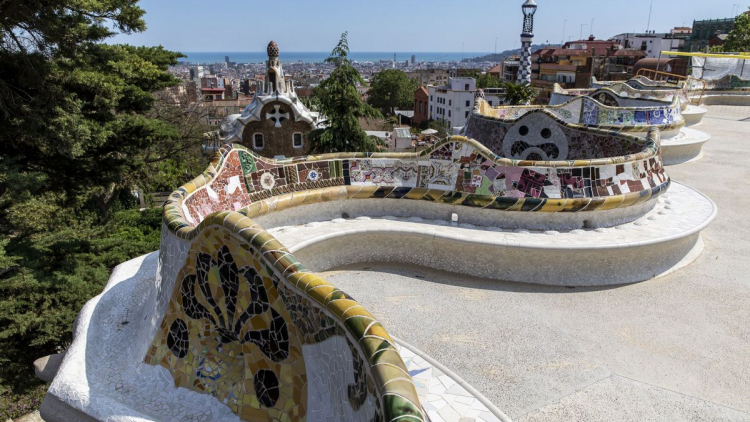Publication of invitation to tender
How can we design an inclusive visit to Park Güell?
Finalist businesses
Award of contract to successful tenderer
Successful tenderer signs the contract
THE CHALLENGE
Barcelona aims to become a more accessible and inclusive city. For years Barcelona has been working to remove architectural barriers and make public spaces accessible to people with various mobility needs. Advancing towards universal accessibility, the city is opting to make use of data and technology to enable individuals with sensory and cognitive diversity to enjoy its public spaces, specifically Park Güell, and thereby guarantee everyone the right to education, leisure and culture.
Universal accessibility means everyone can understand, enjoy and use public spaces independently, in comfort and safety. Environments that are physically, sensorially and cognitively accessible enable individuals with various mobility, visual, hearing or learning needs to use them.
Park Güell, a space managed by Barcelona de Serveis Municipals (BSM), has undergone adaptations and offers people with reduced mobility suggested visiting routes. Even so, there are opportunities for improvements to include people with sensory and cognitive diversity.
Barcelona is calling on disruptive entrepreneurs, organisations and enterprises to put forward innovative solutions based on data and technology to help with achieving accessibility for people with sensory and cognitive diversity at this emblematic city location. The solutions may be intended for one or other space, bearing in mind the specific features and public purpose of each one. The solutions will have to be adaptable and reproducible in other public spaces.
Through this challenge Barcelona is encouraging people and organisations to put data and technology at the service of social needs and thereby help achieve the Agenda 2030 sustainable development goals (SDGs), specifically:
- 3) Health and well-being
- 10) Reducing inequalities
- 11) Sustainable cities and communities
- 15) Life of terrestrial ecosystems.
-
Legislation over the last few decades has enabled public spaces to be designed or adapted to ensure access for people with reduced mobility. Taking another step towards universal accessibility and making the most of technological advances will require innovation to ensure people with sensory or cognitive diversity can access and enjoy public spaces.
Barcelona is a city with 1.6 million residents (data from 2019), roughly 151,814 of whom have some type of disability. That means the prevalence of disability is 9.2% and people in this situation may have difficulties accessing public spaces. We also need to consider visitors to these public spaces who are not Barcelona residents. As for Park Güell, more than 6,000 of all the visitors throughout 2019 had some type of functional diversity (accredited with a certified disability of over 33%).
-
The challenge aims to ensure all visitors to Park Güell enjoy the space independently, comfortably and safely, irrespective of their physical, sensory or cognitive diversity.
We are looking for innovative solutions based on data and technology that make it possible to:
- Ensure people with sensory or cognitive disabilities can interact with the site, for example, through inclusive online tours or tools that enable interaction through touch, smell, conception of the site, perception of shapes and colours, hearing etc.
- Digitise content for its incorporation into visits, taking into account the adaptation of the existing or yet-to-be-developed physical media needed, as well as all the necessary information signposting.
- Explain the history and purpose of the spaces, to make the visit a comprehensive experience.
-
Features of the space
Park Güell
Park Güell is an emblematic space, recognised as a heritage of humanity site by UNESCO, with over a hundred years of history behind it. Despite all the limitations that this represents for architectural adaptation, an itinerary has been sought that goes through accessible places with more or less difficulty and a route enabled through the main points of interest for people with reduced mobility.
The following initiatives aimed at people with reduced mobility have been implemented:
- Accessibility page: https://parkguell.barcelona/app/#/inici
- Reduced-mobility information: https://parkguell.barcelona/ca/accessibilitat
- Virtual tour that could be expanded with more content and by adapting the format to meet specific needs. https://parkguell.barcelona/visitavirtual/
No specific initiatives have been implemented for people with other types of sensory or cognitive disabilities. Given that this is a heritage site, there are considerations and validations that need to be borne in mind for incorporating physical elements, including signposting.
2019
2020
total number of visitors
3,153,973
1,029,669
visitors with functional diversity
6,100
2,486
* Includes all types of disability accredited with certification of over 33%.
Case law and legislation
The importance of promoting accessibility as a tool for enforcing the principle of citizen equality was first highlighted in Catalonia under Decree 100/1984, of 10 April, on the removal of architectural barriers. Seven years later, Parliament approved Act 20/1991, of 25 November, on the promotion of accessibility and the removal of architectural barriers.
The government subsequently enacted Decree 135/1995, of 24 March, implementing that Act and approving the Accessibility Code. These rules established the bases for removing architectural and communication barriers and promoting technical aid for improving the quality of life and independence of people with physical diversity or reduced mobility.
This regulation has led to significant progress in Catalonia, although, after all the years it has been in force in, there are still people with physical, sensory or cognitive diversity who experience situations involving unequal opportunities, discrimination and difficulties for social participation and exercising their rights to communication, education, leisure and culture.
In 1996 Barcelona City Council approved the Municipal Accessibility Plan, which has prioritised and served to plan municipal initiatives in accessibility to public streets and squares for the last 20 years. Following the enactment of the Catalan Accessibility Act in 2014, the Council devised a new accessibility plan adapted to the new needs and challenges of urban life, in accordance with the new regulation.

